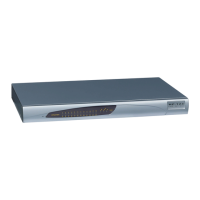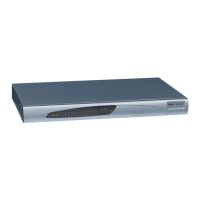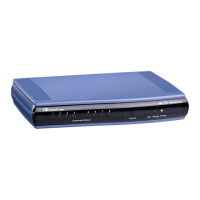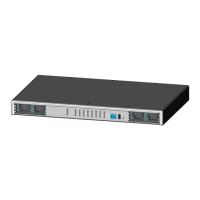Version 7.2 459 Mediant 1000B Gateway & E-SBC
User's Manual 21. Digital PSTN
21.6 ISDN Non-Facility Associated Signaling (NFAS)
In regular T1 ISDN trunks, a single 64 kbps channel carries signaling for the other 23 B-
channels of that particular T1 trunk. This channel is called the D-channel and usually
resides on timeslot # 24. ISDN Non-Facility Associated Signaling (NFAS) enables the use
of a single D-channel to control multiple PRI interfaces.
Note: NFAS is applicable only to T1 trunks.
With NFAS it is possible to define a group of T1 trunks, called an NFAS group, in which a
single D-channel carries ISDN signaling messages for the entire group. The NFAS group’s
B-channels are used to carry traffic such as voice or data. The NFAS mechanism also
enables definition of a backup D-channel on a different T1 trunk, to be used if the primary
D-channel fails.
The device supports up to 12 NFAS groups. Each group can comprise up to 10 T1 trunks
and each group must contain different T1 trunks. Each T1 trunk is called an "NFAS
member". The T1 trunk whose D-channel is used for signaling is called the "Primary NFAS
Trunk". The T1 trunk whose D-channel is used for backup signaling is called the "Backup
NFAS Trunk". The primary and backup trunks each carry 23 B-channels while all other
NFAS trunks each carry 24 B-channels.
The NFAS group is identified by an NFAS GroupID number (possible values are 1 to 12).
To assign a number of T1 trunks to the same NFAS group, use the NFASGroupNumber_x
= groupID (where x is the physical trunk ID (0 to the maximum number of trunks) or the
Web interface (see ''Configuring Trunk Settings'' on page 447).
The parameter DchConfig_x = Trunk_type defines the type of NFAS trunk. Trunk_type is
set to 0 for the primary trunk, to 1 for the backup trunk, and to 2 for an ordinary NFAS
trunk. ‘x’ denotes the physical trunk ID (0 to the maximum number of trunks). You can also
use the Web interface (see ''Configuring Trunk Settings'' on page 447).
For example, to assign the first four T1 trunks to NFAS group #1, in which trunk #0 is the
primary trunk and trunk #1 is the backup trunk, use the following configuration:
NFASGroupNumber_0 = 1
NFASGroupNumber_1 = 1
NFASGroupNumber_2 = 1
NFASGroupNumber_3 = 1
DchConfig_0 = 0 ;Primary T1 trunk
DchConfig_1 = 1 ;Backup T1 trunk
DchConfig_2 = 2 ;24 B-channel NFAS trunk
DchConfig_3 = 2 ;24 B-channel NFAS trunk
The NFAS parameters are described in ''PSTN Parameters'' on page 1074.
21.6.1 NFAS Interface ID
Several ISDN switches require an additional configuration parameter per T1 trunk that is
called ‘Interface Identifier’. In NFAS T1 trunks, the Interface Identifier is sent explicitly in
Q.931 Setup / Channel Identification IE for all NFAS trunks, except for the B-channels of
the Primary trunk (see note below).
The Interface ID can be defined per member (T1 trunk) of the NFAS group, and must be
coordinated with the configuration of the Switch. The default value of the Interface ID is
identical to the number of the physical T1 trunk (0 for the first trunk, 1 for the second T1
trunk, and so on, up to the maximum number of trunks).

